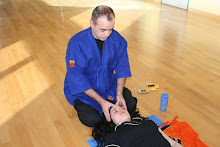
Why do we need to train Yori Ashi? All instructors know that most Shotokan kata movements are executed in characteristically long stepping-in movements (oi ashi). The main reason for such is that the first kata movements were essentially originated as a protection system against the use of long weapons like the bo, jo, katana, and others. The effective distance or range involved in defending against such long weapons was great and required long range movements in order to be effective. Now, of course, we don’t see people walking down the street with these kinds of long traditional weapons, mainly because they can’t be concealed. Times have changed, and because of such, we now see people carrying knives, guns, and other short weapons that can be concealed and kept out of sight until needed. Since the distance or range involved in defending against short weapons is slightly shorter than the one existing against an opponent armed with a long weapon, one long step is simply too much and not very effective in applying defensive techniques at relatively shorter distances. Because of such, a shorter version of the original stepping-in movement can be effectively applied. Such a movement is known as
Yori Ashi - (sliding, gliding movement).
(1) First of all it is necessary to maintain total body control and balance, as well as fully understanding the biomechanics of ground contact and the action-reaction principle stemming from Newton’s third law of dynamics.
(2) Yori Ashi is initiated when the back leg exerts pressure backwards towards the floor and simultaneously thrusting the body’s centre of gravity - and the rest of the body - forwards. This movement coincides with a short forward lunge of the front leg as well as a turning of the hips.
(3) Greater pressure can be exerted backwards thus producing a sharper forward movement of the body if the centre of gravity is maintained low.
Exercises which will improve the execution of yori ashi:
(1) Walk gently forward as if walking upon a thin and fragile sheath of ice.
(2) To execute this technique correctly simply control the internal pressure of the body, making believe - and feeling - that it is suspended from above from a thin chord. At all times the body must be maintained perpendicular to the ground.
(3) Each step must be controlled with the abdominal muscles of the tanden making believe - and feeling - that one is walking on a thin and fragile sheath of ice. (4) From that point on, and in the kamae position, one must exert pressure with the tanden and simultaneously glide the body forward executing a clean yori
ashi movement. (5) The ground forces of acceleration
and deceleration are used twice in each yori ashi. The first occurs simultaneously with the initial acceleration thrust of the back leg towards the ground, and the second is when the front leg; e.g. decelerates and completes the forward movement.
At all times it must be kept in mind that in regular training sessions traditional karate techniques are stopped just short of making full contact upon the opponent. This technique is known as control. However, the application of control does not mean the energy transference capacity of the karate technique remains low - all to the contrary. All techniques of traditional karate are controlled with a high degree of precision due to their extremely high energy transference capacity.
Such transference of energy or momentum is known as kime - the essence of traditional karate. Though a karate practitioner does not make full contact upon his opponent, he must conceive the technique as real and fully delivered upon its target. The technique stops physically but not mentally. An important component of internal energy must be transmitted even when the technique is pulled short. The technique stops externally but not internally - the external component is known as zanshin.Nelson Carrion
www.karate-institute.net


